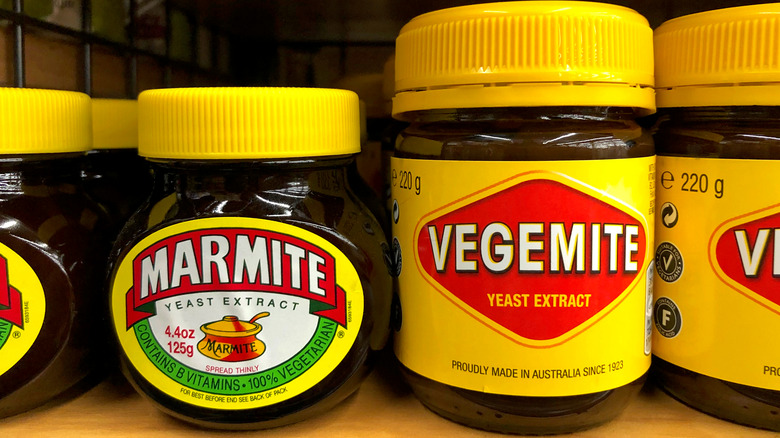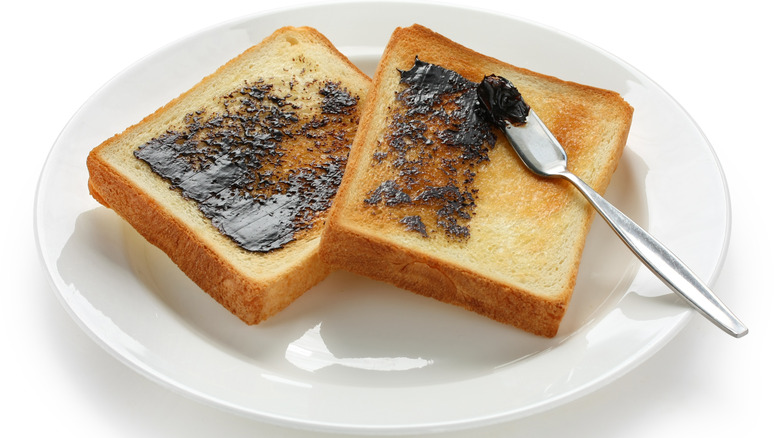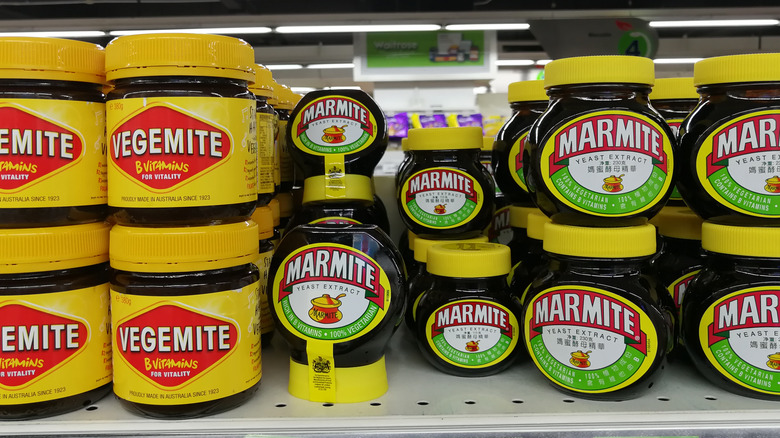The Difference Between Vegemite And Marmite
When it comes to Western spreads that end in "ite," there's one product that automatically springs to everyone's mind: Promite. You know, Mars Inc.'s smooth and tasty veggie paste often slathered atop toast? It's so beloved that when Choice — a leading Australian consumer advocacy group — conducted a taste test of Promite, participants described it with the following colorful words: "barely edible," "I feel sick," "like a petrochemical," "unholy," and "why so fishy?"
Humorous reactions aside, there genuinely is a market for the product, which is often joined by similar brands like OzeMite and AussieMite on store shelves. Still, there's obviously a much bigger market for Marmite and Vegemite, the time-tested condiments that Promite and the rest are competing with on the market. Just like Promite, though, Marmite and Vegemite garner strong reactions from people; chef Nigella Lawson swears by Marmite as a stock shortcut and Vegemite is literally electrifying. What are they really, though, and what are the differences (if any) between them?
Marmite and Vegemite have distant origin points
These two culinary products are actually quite similar. Marmite and Vegemite both come from leftover brewer's yeast mixed with veggies. They share related histories, too, as one was inspired by the other.
In the late 1800s, scientists realized brewer's yeast — beer brewing's sludgy byproduct — was rather nutritious, especially with respect to its vitamin content. So, circa 1902, England's Marmite Food Company started producing the stuff as a comestible. From there, it spread to various English-speaking nations, like Australia and New Zealand, but it remains most famous in the United Kingdom. The World Wars especially bolstered its fame, since Marmite helped keep soldiers well fed.
However, WWI made it difficult to import Marmite into Australia. So, Vegemite was invented (about two decades after Marmite) by Cyril P. Callister, who specifically set out to develop an Australian version of Marmite. Over the course of WWII, like Marmite, this spiritual successor spread also became known for its nutritiousness.
Nowadays, Marmite and Vegemite enjoy parallel popularities in their separate homelands.
Marmite and Vegemite profiles vary
Made from essentially the same stuff, Marmite and Vegemite are mostly alike. Both of them are thick, shiny, dark brown pastes, but Marmite is somewhat thinner and paler in appearance than Vegemite. Still, the two are often lumped together, being described as being bitter, salty, and rich, with some likening them to bread, meat, or soy sauce in taste.
Product variations exist. Marmite, for example, once released a special edition that had a subtly smooth Guinness taste thanks to yeast from the famed Irish stout. It also featured a sweeter Champagne twist at one point in time. Later, a more intense version called "Marmite XO" came about, catering to those who enjoy strong sensations. Vegemite provides shoppers options, as well, offering up variations like its cheesy flavor.
Although sharing similarities, the culinary profiles of Marmite and Vegemite garner rather strong opinions. The experience of eating such a paste tends to be divisive, with consumers either adoring or loathing it. Customers also tend to have brand loyalty when it comes to comparing the two. However, these sentiments might prove a bit artificial; Marmite once ran an "I Love Marmite versus I Hate Marmite" campaign, for instance, and Vegemite has become a point of pride for the Land Down Under, one that's arguably more about patriotism than culinary preference. The difference between Marmite and Vegemite may mostly be effective marketing. Even so, some swear Vegemite is heavier and more savory, while Marmite is saltier and sweeter.
Marmite and Vegemite feature in different recipes
Speaking of Down Under, the popular Australian rock band "Men At Work" famously sang about being given a Vegemite sandwich by a smiling baker in Brussels (who was "six-foot-four and full of muscle"). This fun little musical reference is probably the thing Vegemite is most famous for outside of Australia. Pop culture aside, though, this song truly does hint at the usefulness of Vegemite and, hand-in-hand, its Marmite relative.
Marmite originated as a spread and is most often used in sauces and stews or on toasted bread. Other Marmite branded products include cheeses, nuts, and rice cakes, ideal for pairing with Marmite. The stuff also goes well with cooked eggs, fresh veggies, noodle dishes, and even cocktails such as the Bloody Mary.
Naturally, much of the same can be said about Vegemite, which was designed to be a firm jelly. So, it often finds its way onto crackers and sandwiches. Vegemite was additionally intended to benefit soups and gravies, as well. Australian bakers now use it to fill pastries from time to time, and anything from burgers and casseroles to glazes and pizzas can be improved with Vegemite, too. On top of that, those who avoid meat may especially appreciate Vegemite's ability to replicate meaty flavors in their vegetarian or vegan recipes. You can also shake some up in an espresso martini.
Marmite and Vegemite have contrasting health benefits
For both Marmite and Vegemite, brewery yeast is broken down using heat and salt. Afterward, water and solid residue get filtered out, leaving behind a concentrated liquid that's flavored with various ingredients. Even so, the exact methods used do result in some minor nutritional differences.
Marmite is low in carbs, calories, and fats. It's also chock-full of minerals and vitamins. Its B vitamins in particular can help those with related deficiencies causing a variety of symptoms, according to WebMD. Those vitamins may also improve brain and heart health, though this has not been definitively proven yet. Marmite features plenty of folic acid, too, which can be helpful for pregnant people (via Marmite). The only real downside is the somewhat high sodium content, and it is possible for some individuals, especially little kids, to be allergic to the stuff.
As expected, Vegemite can similarly play a beneficial role in one's health if incorporated correctly. It also has high quantities of B vitamins, per Healthline; Vegemite and Marmite primarily differ on which B vitamins they have the most of. Vegemite is similarly low in carbs, fats, and sugars, but it's just as high in sodium as Marmite. It may bolster mental health, counteract fatigue, and reduce the risk of heart disease, too, though studies are ongoing. Vegemite even has a history of being used as baby food.
Despite a few dissimilarities here and there, it's no wonder why Marmite and Vegemite simultaneously reign supreme.




